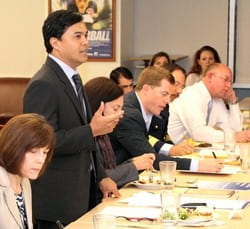 The March earthquake, tsunami, and radiation disaster in Japan offers a stark reminder of the need to prepare for emergencies and natural disasters. While most of the public’s attention is focused on transportation and energy infrastructure needs, an equally important but often neglected aspect of civil preparedness is developing the proper communication infrastructure in advance of a crisis.
The March earthquake, tsunami, and radiation disaster in Japan offers a stark reminder of the need to prepare for emergencies and natural disasters. While most of the public’s attention is focused on transportation and energy infrastructure needs, an equally important but often neglected aspect of civil preparedness is developing the proper communication infrastructure in advance of a crisis.
To address this need, the Center on Communication Leadership & Policy’s Research Director Mark Latonero is helping the Center for National Policy to develop the necessary communications strategies and social media approach to prepare the public for emergencies and natural disasters. As a partner involved in CNP’s Task Force for a Resilient America, Latonero will lend his research expertise in information and communication technology to a coalition of policymakers and emergency personnel, who ultimately hope to create an effective strategic message for responding to disasters.
CNP launched its inaugural meeting for the Task Force for a Resilient America on April 25th, co-hosted by Participant Media and Take Part, which produced such films as An Inconvenient Truth, The Cove, and Waiting for Superman. The meeting brought together a distinguished group of policymakers, stakeholders, and emergency preparedness professionals, including representatives from Twitter, the Los Angeles Sherriff’s Department, United States Coast Guard, and USC’s Homeland Security Center, CREATE.
A featured discussion leader on social media and emergency response, Latonero shared his expertise on information communication technology.
“Social networking gives individuals the unprecedented ability to quickly broadcast and exchange small amounts of information with large audiences, over vast distance,” said Latonero at the April 25th meeting in Beverly Hills. “Such affordances are useful during times of emergency and crisis as information changes unexpectedly and needs to be disseminated rapidly.”

The task force explored how various media outlets create awareness of civil preparedness plans and bridge public perception and reality about emergency procedures. One message that emergency responders are trying to communicate to the public is the need to individually prepare for the first seventy-two hours after disaster strikes. In the case of a major catastrophe, first responders will not have the capacity to address the huge influx of individual calls for help. While the public has an expectation that the fire department will be available to respond to their calls within minutes, the reality is that people need to be self-sufficient for at least three days.
“We are proud to partner with USC’s Annenberg School on a project that we believe will make an important contribution to building a more resilient nation and a safer world,” explained Scott Bates, Vice-President of the Center for National Policy. “Our partners at the Annenberg School have helped provide the analysis and leadership that is making our work useful for practitioners and policymakers at the national level.”
The April gathering was the first in a series of task force meetings throughout the spring and summer, which will be hosted in New York and Washington, D.C. and correspond with the release of a complete report of its findings and recommendation.
For more information about the Task Force, visit the Center for National Policy’s website.